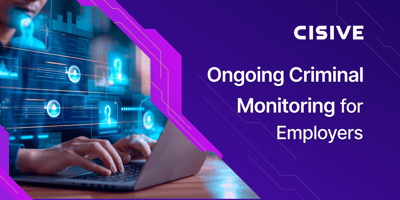

In this Cisive Product Highlight series, we’ll review key tools to consider when screening your...

In this Cisive Product Highlight series, we’ll review key tools to consider when screening your workforce, as well as top benefits and features when ordering them through Cisive and our family of brands.
This month’s highlight is Fingerprinting, a process for fingerprint capture which returns criminal and civil data, usually in regulated industries.
Fingerprinting is the process of collecting fingerprints either electronically (live scan) or manually (hardcopy ink-and-roll) for the purpose of processing a background check. It helps employers verify a candidate’s basic information, as well as arrest information and outcomes. While many people may share the same name, each of us has a unique fingerprint, ensuring you have the correct information on your applicant.
The fingerprint background check is submitted to the Federal Bureau of Investigation (FBI), the Financial Industry Regulatory Authority (FINRA), the Nationwide Multistate Licensing System & Registry (NMLS), or the Defense Counterintelligence and Security Agency (DCSA), depending on your organization’s industry and regulatory requirements.
For clients utilizing hardcopy print cards for DCSA, these can be converted into a Secure Web Fingerprint Transmission (SWFT) compliant format. Cisive can then upload SWFT fingerprints (both those sent in hardcopy and those captured electronically) to the DCSA’s Fingerprint Transaction System (FTS) on their behalf.
Cisive provides our clients’ applicants with 800+ live scan fingerprint capturing locations nationwide, allowing them to choose a convenient location. Cisive’s brand for government employment screening solutions, ScreenID (previously Inquiries Screening), is one of only a few Consumer Reporting Agencies (CRAs) on the list of 13 approved channelers nationwide for Electronic Fingerprint Submission (EFS).
Any authorized organization can include fingerprinting as a part of their background screening package, or as a standalone product.
However, many industries and job positions require a fingerprint background check, including financial services, mortgage lenders, public schools, daycare providers, government employees, and some healthcare workers.
Cisive also has the ability to provide fingerprinting services to our clients’ vendors as needed.
A fingerprint background check will yield a Criminal History Record Information (CHRI) report. The CHRI may include:
Cisive also offers CHRI Perfection. If there is missing information on a CHRI report, clients can submit this report back to Cisive for further investigation. For example, if there is an arrest record on the CHRI, but no additional information, Cisive can conduct a county search based on that arrest record to provide clients with a more complete picture.
Cisive Clients
Your organization can either order a fingerprint background check as a part of your integrated background check package, or as a standalone report. Once the product is ordered, Cisive takes it from there!
If the applicant needs support at any point in the process, they can contact Cisive’s Help Desk directly, relieving this burden from our clients.
Applicants
Once a fingerprint background check has been ordered, the applicant will be invited to Cisive’s platform to select a convenient fingerprint collection location near them. They will also provide Cisive the personal data required by the FBI, including biographical data such as height, eye color, etc. This data is securely stored by Cisive, and only the applicant name is embedded in a QR code that the applicant will then provide to the fingerprint technician. This reduces the amount of Personally Identifiable Information that is transmitted and viewed by the technicians.
The applicant then makes their way to the fingerprint collection location to scan their QR code and provide their fingerprints using live scan technology.
Cisive strongly recommends electronic fingerprint capture, also called live scan. Live scan is by far the fastest and most cost-effective option, compared to the manual hardcopy “ink-and-roll” method.
A hardcopy fingerprint card incurs an extra processing fee as well as the card expense, has lower image quality causing a higher rate of rejected fingerprints, and takes longer to process.
With live scan, the fingerprint technician can work with the applicant to ensure any problems that may result in illegible prints are resolved on the spot, allowing an applicant multiple tries until the perfect fingerprint is collected.
Additionally, with live scan, through Cisive’s Fingerprinting solution, the applicant’s personal data is more secure. Only the first and last name are embedded in a QR code provided by Cisive that the applicant takes with them to the fingerprint capturing location, and it’s transmitted electronically from there.
Historically, with a hardcopy fingerprint card, the applicant’s personal data is collected on a physical card and changes hands through the submission process, exposing the applicant’s data to whoever sees the card.
Fingerprinting alone, while useful, is best supplemented with a more thorough background check, including county criminal searches. With CHRI Perfection, Cisive can fill those missing information gaps for you. Contact Cisive to develop a thorough background screening program that meets your regulatory requirements and fits your organization’s needs.
Author: Jenni Gallaway
Bio: Content Marketing Manager at Cisive. 8 years of experience in the background screening industry.
Let's Connect on LinkedIn
In this Cisive Product Highlight series, we’ll review key tools to consider when screening your...

In this Cisive Product Highlight series, we’ll review key tools to consider when screening your...

In this Cisive Product Highlight series, we review key tools to consider when screening your...